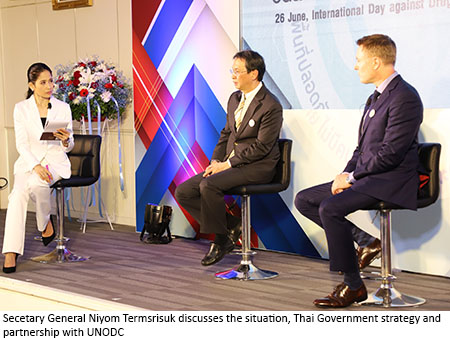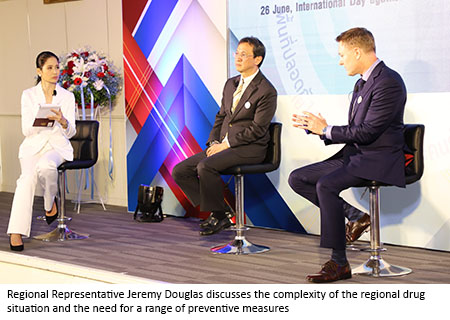
Bangkok (Thailand), 26 June 2020 - Commemorating World Drug Day 2020, the Office of the Narcotics Control Board of Thailand (ONCB) invited UNODC to jointly brief the press, Government and international partners on the illicit drug situation and efforts to prevent continued growth of the regional market. Secretary General of the Office of the Narcotics Control Board of Thailand, Niyom Termsrisuk, noted at the outset, “Thailand and UNODC share the same interests, including helping the Mekong and Southeast Asia, and our longstanding partnership remains integral to our strategy to prevent and address organized crime and related illicit drug production, trafficking and use in the region.”
The regional drug market has expanded and become increasingly complex in recent years, with UNODC’s latest synthetic drug report highlighting the fact seizures of methamphetamine in East and Southeast Asia have increased year-on-year over the last decade. This intensified supply has been accompanied by lower street prices while purities and potency have increased. Concerningly, East and Southeast Asia have also experienced a rapid rise in a wide range of new synthetic drugs as organized crime continue to push the limits of the trade.
As the situation has evolved and deteriorated, the ability of governments to understand which drugs are produced, available and being used has become increasingly important. “The regional drug market is not what it used to be – it has changed significantly in just a few years,” remarked Jeremy Douglas, UNODC’s Regional Representative for Southeast Asia and the Pacific. “Beyond crystal and yaba methamphetamine we are receiving and seeing reports of ketamine, potent new synthetic opioids, and ecstasy in the region, and many governments do not grasp the significance of this diversity, while users often fail to understand that these drugs can have unknown ingredients and can be very harmful.” He added that prevention messages emphasizing the significance of the changes that have occurred in the regional market are important, and he commended the Royal Thai Government and the ONCB for the new ‘Safe Zone, No New Face’ campaign.
The expansion and diversification of the drug trade has been accompanied by reports of different precursor and pre-precursor chemicals being trafficked and detected by law enforcement authorities in the Mekong and surrounding region. But at the same time, most countries do not have the capacity to analyse and accurately confirm many new substances and chemicals. “As synthetics have overtaken East and Southeast Asia the need for testing and profiling has become more important – something many governments have yet to fully appreciate,” commented Regional Representative Douglas. “Reliable forensic information is essential to ensure fair investigations and criminal justice processes, and to save lives. Reinforcing related capacities and preventing precursor chemical diversion and trafficking are clearly top priorities.”
Solutions also require collaboration, and the partnership with Thailand and other countries in the region through frameworks like the Mekong MOU are a natural starting point. Secretary General Termsrisuk emphasized, “the challenge we face together is significant, and we will only be able to be successful by working together and by strengthening regional and international cooperation, particularly with our Mekong partners and UNODC with whom we share an action plan. We are pleased we will be expanding our joint efforts in coming months.”
Click here to learn more about UNODC's Regional Programme for Southeast Asia
Click here to download the report Synthetic Drugs in East and Southeast Asia: Latest Developments and Challenges
Click here to learn more about UNODC regional work on drugs and precursors
Click here to learn more about UNODC regional work on border management
Click here to learn more about UNODC regional work on drug prevention
Click here to learn more about the Mekong MOU